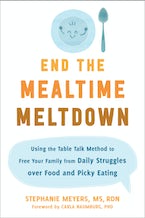By Stephanie Meyers, MS, RDN, author of End the Mealtime Meltdown
My daughter came home from a party recently with three jumbo bags of cotton candy, which unsurprisingly she wanted to eat straightaway. Instead of saying, “That’s too much sugar—it’ll ruin your dinner,” I said, “Tell me about cotton candy for you.” That might sound odd, but it’s one way I help parents who ask me how to talk about food without labeling it “healthy” vs “unhealthy.”
There’s a lot of advice out there about “food neutrality,” but most ideas I’ve seen still categorize foods as “good” or “bad,” just in a fancified way. For example, an article from a prominent Children’s Hospital titled, “How to Help Your Child Create a Positive Relationship with Food,” suggests ditching phrases like, “this food is bad for you,” and saying instead: “This food does not give us as much energy for the day,” or “Let’s think about the best option to fuel us for the day.” Can you hear how those phrases maintain the status quo of “healthy” vs “unhealthy?” Telling a child to think of the “best” kind of fuel insinuates there are “worst” kinds of fuel, right? When your child asks for cotton candy, replying with, “let’s think about the best option to fuel us,” merely gives the illusion you’re not labeling that choice as “bad.”
Other popular blogs and social media influencers suggest telling kids what foods do in their body. For example, “Red foods give you a strong heart,” and “Green foods help you not get sick.” But it’s confusing for kids when foods like ketchup and red licorice aren’t given that healthy-heart sanction. And what happens when kids inevitably get sick? Some start to worry it’s because they don’t eat enough green foods. These ways of talking to kids still classify food (and eating behaviors) as “good” and “bad.” So, what can you do if you truly want to remove the concept of morality from food?
Three things you can do to stop labeling food “healthy” or “unhealthy” include:
1. Identify ways you talk about food as “good” or “bad,” in your own life.
In the next few days write down how you talk about food, out loud and in your own head. Maybe you say, “I’m eating bad snacks,” or “that cake isn’t a healthy choice.” Jot these phrases down, without judging yourself. Once you’ve got about ten phrases, take a closer look at your words.
Which of your comments evaluate food based solely on thinking? Judging food as “healthy” or “unhealthy” is a cognitive process. And while you might think brain-based learning about nutrition is critical for establishing healthy habits, it’s not the most important or effective way to inspire kids to eat well. Acquiring nutrition facts doesn’t help kids eat better. It serves what parents need. When you hear yourself thinking or speaking about food in two categories (healthy/unhealthy), turn your attention inward to see what’s happening below your brain with food.
2. Explore the sensory experiences happening while you eat.
Do this for yourself and also with your child. A familiar tune can help you get started. Sing the song below (out loud or in your head) as you eat a meal or snack. It will help you get curious about what’s happening with your senses as they come into contact with food.
[Sung to the tune of Head, Shoulders, Knees & Toes]
Eyes, nose, mouth and stomach; mouth and stomach.
Eye, nose, mouth and stomach; mouth and stomach.
Ears and hands and heart and mind.
Eyes, nose, mouth and stomach; mouth and stomach.
Take note of what you feel in each of these places while you eat, as best you can. Using the cotton candy example, you could sense how it looks and smells to you. How does it feel on your tongue? What happens moment to moment in your mouth and/or stomach after taking a bite? How do you know when you’ve had enough cotton candy? Where in your body do you go to get that information?
This mindful way of eating allows labels like “healthy” and “unhealthy” to drop away. It also gives you reliable answers to the questions listed above. Cotton candy might feel pillowy and sweet tasting with fibers that dissolve instantly on your tongue. That’s not good or bad for your health, it’s simply a lived experience. Paying attention to what your senses observe with food is a valuable and trustworthy touchpoint that frees you from external labels like calling food “good” or “bad.” This is one skill of eating we must nurture in kids. And you can engage this with new ways of talking about food, which brings us to the third thing you can do.
3. Change what you say to your child about eating.
Educate less and explore more. Use open-ended questions like, “What do you notice about cotton candy?” or “How’s cotton candy look/smell/feel for you?” When you want to convey nutrition knowledge, balance that with an open-ended question. Don’t say, “Cotton candy is full of sugar and food dyes” (that’s labeling food “bad”). Even if you think, “It’s junk,” saying that probably won’t change your child’s interest in that food. Instead, describe cotton candy from your own sensory experience. Say, “For me, cotton candy is airy and really sweet [insert your own adjectives],” then follow that by asking your child, “How’s cotton candy for you?”
Undoing patterns of labeling food “healthy” and “unhealthy” involves deemphasizing the thinking mind and sensing into the body, which is where the magic really happens with food. Changing how you talk to your kids about eating so it aligns with this approach is a novel leverage point for cultivating a positive relationship with food.
Many parents still wonder, however, what’s wrong with calling foods “healthy?” They want their kids to choose quality foods, so why can’t they just name that? If you eat with kids, you already know the headspace they embody as eaters. They take their time looking, touching, smelling, and squishing stuff up. Their senses are on, and their minds are open more than we might give them credit for. Meeting your kid where they’re at as an eater is the most organic way to help them choose foods that satisfy them. Removing labels like “healthy” and “unhealthy” doesn’t make you lose out on anything. In fact, it teaches your child not to side against themselves when it comes to food. It’s interrupting thought patterns like, this isn’t good for me, I shouldn’t be eating this, and showing your child how to trust their own bodily experiences with food
Stephanie Meyers, MS, RDN, is a registered dietitian nutritionist and founder of Families Eating Well, a nutrition practice training parents to coach healthy eating habits in kids. She is nutrition coordinator in The Zakim Center for Integrative Therapies and Healthy Living at Dana-Farber Cancer Institute, and a former instructor in the graduate nutrition department at Boston University. She presents seminars worldwide on mindful eating, family nutrition, and cancer survivorship.



 2024 Peace Playbook: 3 Tactics to Avoid Clashes with Your Partner
2024 Peace Playbook: 3 Tactics to Avoid Clashes with Your Partner